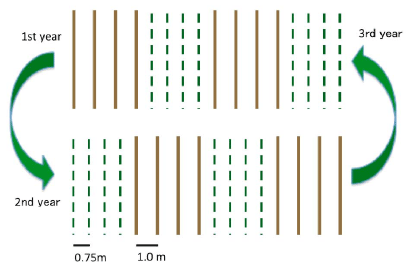Combination effect of planting density and 4:4 crop design in the system of millet/cowpea rotation in the Sahel, West Africa
Description
Integrated soil fertility management is not only intended to add nutrients but also to include appropriate legume crops, density and crop design. In the Sahel of West Africa, poor farmers cannot afford to buy enough chemical fertilizers, organic manure or both. An alternative such as rotation with optimized planting density of selected varieties of legumes in an intercropping system with cereals would be a low-cost input technology.
An improved cowpea (Vigna unguiculata) variety, TN256-87, has been selected in the project (JIRCAS Research Highlights, 2006). It is a dual-purpose (both for grains and fodder) and high density-tolerant cultivar compared to local ones. For crop design, one row of the local variety of pearl millet (Hini Kirey, Pennisetum glaucum) followed by one row of local cowpea (1:1) represented the farmers’ traditional method in the Sahel. In this study, four rows of local millet followed by four rows of improved cowpea (4:4) would be proposed as a new method to assist farmers in conducting the rotation more simply and easily (Fig. 1). The combination effect of three cropping densities of the improved cowpea with one cropping density (5882-6275 plants/ha as low) of the local pearl millet, two crop rotations (with or without rotation) and two crop designs (1:1 and 4:4) were evaluated in the experimental station at Sadore, ICRISAT, West and Central Africa, Niger, for three years. The results indicate that the crop rotation significantly increased total biomass by 39%, millet yield by 50% (Fig. 2, 3). And on the other hand, the 4:4 crop design didn’t adversely reduce total biomass and millet yield. The crop density also didn’t affect the millet biomass and yield owing to the high density-tolerant variety of cowpea.
In conclusion, the combination of four rows of local millet with low density (6,300 plants/ha) followed by four rows of cowpea with low to high densities (6,300 – 32,000 plants/ha, depending on the variety) is highly recommended for farmers to be able to carry out a cereals-legumes rotation more simply and effectively in their fields.
Figure, table
-
Fig. 1. 4:4 crop design and its rotation in millet/cowpea -
Fig. 2 Effects of crop rotation (left), crop design (middle), and crop density (right) on crop biomass.
A dual-purpose cowpea variety, TN256-87, was used. Crop densities for cowpea consisted of low (5,900 – 6,300 plants/ha), medium (11,000 – 12,000 plants/ha) and high (29,000 – 32,000 plants/ha) densities, while low (5,900 – 6,300 plants/ha) density only for millet. Different alphabets indicate results are statistically significant at 5% level (Student t). -
Fig. 3. Effects of crop rotation (left), crop design (middle), and crop density (right) on crop yield.
The cowpea variety and crop densities are the same as Fig. 1. Different alphabets indicate results are statistically significant at 5% level (Student t).
- Affiliation
-
Japan International Research Center for Agricultural Sciences Crop Production and Environment Division
- Classification
-
Research A
- Term of research
-
FY2008~2010
- Responsible researcher
-
SAIDOU Addam Kiari ( Institut National de Recherche Agronomique du Niger )
OMAE Hide ( Crop Production and Environment Division )
TOBITA Satoshi ( Crop Production and Environment Division )
- ほか
- Publication, etc.
-
Kiari et al. (2010) Combination effect of crop design and crop densities in the system of millet/cowpea rotation in the Sahel, West Africa. American-Eurasian Journal of Agricultural and Environmental Science. 7(6): 644-647.
https://doi.org/10.20710/dohikouen.55.0_138_2Omae et al. (2009) Combination effect of chemical fertilizer and organic matters in the millet/cowpea intercrop under sandy soil conditions of the Sahel, Africa. Abstracts of the annual meeting, Japanese Society of Soil Science and Plant Nutrition Vol.55.
Kiari et al. (2009) Planting density and cropping pattern effect on biomass of millet/cowpea in rotation as sandy soil management in Western Niger. 5th conference of the Africa Soil Science Society.
- Japanese PDF
-
2010_seikajouhou_A4_ja_Part2.pdf82.21 KB



